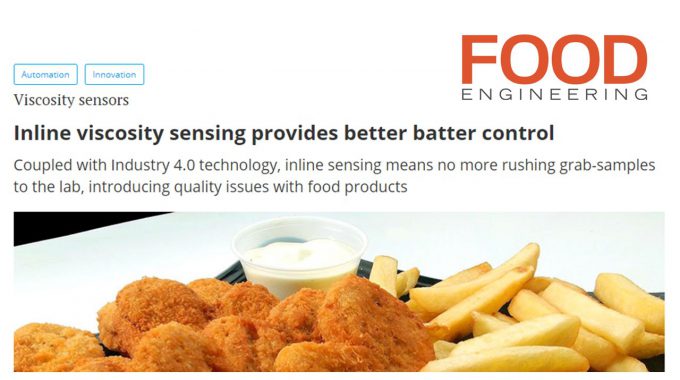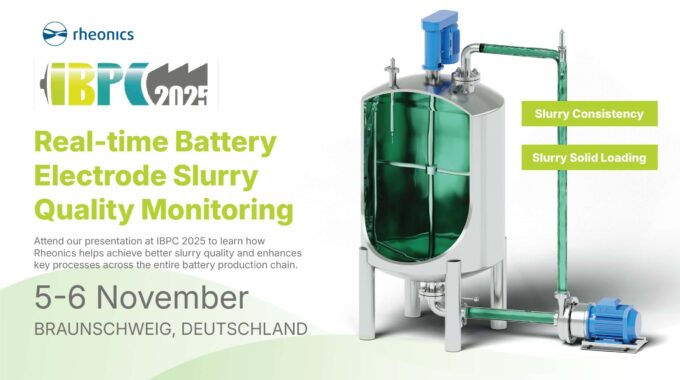
Food Engineering Magazine features Rheonics – “Inline viscosity sensing provides better batter control”
Overview
Food industry focused magazine – Food Engineering Mag (https://www.foodengineeringmag.com/) publishes a feature article covering the Rheonics inline viscometer SRV and the integrated solution – Rheonics Production Monitoring and Control System. The article discusses why batter consistency is critical and how it can be ensured in the preparation and the applicator(coating) unit in the factory even under varying temperatures and evaporation conditions through automation of the dosing system with a controller using continuous, real-time viscosity measurements.
Find the link to the the publication.
To read the full article on our website, please use the link below.
Introduction
Batter viscosity is crucial to functionality
Consistency of the batter during coating is crucial to ensuring cost-effective, repeatable and uniform product. Viscosity plays a super-sized role in ensuring controlled consistency of batter mixes. However, ensuring and monitoring viscosity of batter mix or coating is not trivial. Batters are complex fluids. They typically consist of a number of dispersed phases such as flour, fat, water and air. Sufficient viscosity is required to stop phase separation during mixing, floor time and baking in the oven.
Consistency of the batter for fried chicken is all important to maintain quality, and in-line viscosity monitoring and control can get it right all the time, as opposed to waiting for grab-sample results from the lab, which will never be the same as what’s in the pipe.
Key value of inline batter consistency monitoring and control solutions
Closed quality control loops and the increasing degree of viscosity automation enabled by the SRV viscometers add value to the production process in terms of quality, consistency, reduced wastes, efficiency and productivity. Human error is avoided, and fully automatic correction of any deviation in the manufacturing process becomes possible.
Data provided by the Rheonics viscometers and integrated solutions helps to accelerate learning curves and accommodate more frequent food product composition changeovers, contributing to a more resource-efficient, economical and greener manufacturing process.
In cases where asset productivity and OEE are key and maintenance costs are significant, actionable data provided by the viscometer solution helps food manufacturers cut down on process interruptions with predictive maintenance for production tools and machines. Forecasting potential downtime events and quality diagnosis are enabled by data provided by the sensors.
To know more about why food manufacturers are looking to integrate automation solutions in their production/factory floors, please read our article titled – “Digital food processing – drivers for manufacturers’ embrace of Industry 4.0”
Unique advantages with the Rheonics SRV sensors
Rheonics sensors have built-in temperature measurement, permitting the temperature of the batter to be monitored at the point of application. This permits the viscosity readings to compensated for temperature, which is essential for ensuring consistent production through typical daily and seasonal temperature variations.
There are many benefits to using an inline viscosity sensor like the SRV for batter mixing and coating applications. and some include:
- Works accurately in most coating systems with a broad range of batter compositions and related products—adhesion batter, glazes, sauces, marinations, breaders, pre-dust
- Maintains the set batter viscosity even while water or breading from the product mixes with the batter in the batter applicator during production.
- Rugged, hermetically sealed sensor head. The SRV can be cleaned inline with all standard CIP processes, or with a wetted rag, without the need for disassembly or recalibration
- No moving parts to age or foul with sediment
- Insensitive to particulate matter; no narrow gaps to foul with particulates
- All wetted parts are 316L stainless steel—meets sanitary norms with no corrosion problems
- Hygienic, sanitary design for food and beverage applications—available in tri-clamp and DIN 11851 connections for easy operation and cleaning
- Certified under ATEX and IECEx as intrinsically safe for use in hazardous environments
- Wide operational range and simple integration—Sensor electronics and communication options make it extremely easy to integrate and run in industrial PLC and control systems.
To explore more about our solutions for batter quality control, please read the application note.
To read Rheonics’ study about correlation with lab rotational viscosity measurements, please read the linked article below.
Conclusion
Food manufacturers strive to satisfy consumers’ often cited several textural and mouthfeel properties as the basis for why they like the “taste” and how the texture and mouthfeel, combined with health consciousness and demand for clean-label products influences continued consumption decisions. Viscosity is important in preparation and application of all types of batter – adhesion, cohesion and tempura batters.
Key takeaways:
- Vibrational viscometers, such as the Rheonics SRV, come closer to matching the high shear rates in batter coating than do rotational or cup viscometers. Therefore, measurements with the SRV come closest to predicting the behavior of batter under actual coating conditions.
- Inline viscosity control with the SRV and Rheonics Production Monitoring & Control system enables continuous viscosity control, making necessary dilutions in real time. Consistency is guaranteed regardless of temperature fluctuations, mixing equipment condition, type and conditions of substrates, batter formulations, process step interactions and mixing time parameters.
- Rheonics SRV and Production Monitoring and Control system control true temperature-compensated viscosity, which is essential for ensuring consistent production through typical daily and seasonal temperature variations.
Using the SRV sensor in batter mixing or coating line results in improved productivity, profit margins and regulatory compliance.
Once the process parameters are established, there is little effort required to maintain the integrity of the process. Operators can rely on the tight control provided by the Rheonics batter quality management solution and reap benefits not only in production, but also the product R&D stage when the formulation parameters are established. This enables the operator to gain competitive advantage as production is scaled up to meet increasing demand.


